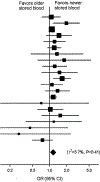RBC Storage Lesion Studies in Humans and Experimental Models of Shock
- PMID: 38362479
- PMCID: PMC10868675
- DOI: 10.3390/app10051838
RBC Storage Lesion Studies in Humans and Experimental Models of Shock
Abstract
The finding of toxicity in a meta-analysis of observational clinical studies of transfused longer stored red blood cells (RBC) and ethical issues surrounding aging blood for human studies prompted us to develop an experimental model of RBC transfusion. Transfusing older RBCs during canine pneumonia increased mortality rates. Toxicity was associated with in vivo hemolysis with release of cell-free hemoglobin (CFH) and iron. CFH can scavenge nitric oxide, causing vasoconstriction and endothelial injury. Iron, an essential bacterial nutrient, can worsen infections. This toxicity was seen at commonly transfused blood volumes (2 units) and was altered by the severity of pneumonia. Washing longer-stored RBCs mitigated these detrimental effects, but washing fresh RBCs actually increased them. In contrast to septic shock, transfused longer stored RBCs proved beneficial in hemorrhagic shock by decreasing reperfusion injury. Intravenous iron was equivalent in toxicity to transfusion of longer stored RBCs and both should be avoided during infection. Storage of longer-stored RBCs at 2 °C instead of higher standard temperatures (4-6 °C) minimized the release of CFH and iron. Haptoglobin, a plasma protein that binds CFH and increases its clearance, minimizes the toxic effects of longer-stored RBCs during infection and is a biologically plausible novel approach to treat septic shock.
Keywords: blood transfusion; cell free hemoglobin; haptoglobin; iron; pneumonia; sepsis; shock.
Conflict of interest statement
Conflicts of Interest: The authors declare no conflict of interest.
Figures



Similar articles
-
Transfused older stored red blood cells improve the clinical course and outcome in a canine lethal hemorrhage and reperfusion model.Transfusion. 2015 Nov;55(11):2552-63. doi: 10.1111/trf.13213. Epub 2015 Jul 15. Transfusion. 2015. PMID: 26175134 Free PMC article.
-
Role of heme in lung bacterial infection after trauma hemorrhage and stored red blood cell transfusion: A preclinical experimental study.PLoS Med. 2018 Mar 9;15(3):e1002522. doi: 10.1371/journal.pmed.1002522. eCollection 2018 Mar. PLoS Med. 2018. PMID: 29522519 Free PMC article.
-
In a canine pneumonia model of exchange transfusion, altering the age but not the volume of older red blood cells markedly alters outcome.Transfusion. 2015 Nov;55(11):2564-75. doi: 10.1111/trf.13275. Epub 2015 Sep 7. Transfusion. 2015. PMID: 26469998 Free PMC article.
-
Transfusion of red blood cells stored for shorter versus longer duration for all conditions.Cochrane Database Syst Rev. 2018 Dec 22;12(12):CD010801. doi: 10.1002/14651858.CD010801.pub3. Cochrane Database Syst Rev. 2018. PMID: 30578732 Free PMC article.
-
The red cell storage lesion(s): of dogs and men.Blood Transfus. 2017 Mar;15(2):107-111. doi: 10.2450/2017.0306-16. Blood Transfus. 2017. PMID: 28263166 Free PMC article. Review.
Cited by
-
Large Animal Models for Simulating Physiology of Transfusion of Red Cell Concentrates-A Scoping Review of The Literature.Medicina (Kaunas). 2022 Nov 27;58(12):1735. doi: 10.3390/medicina58121735. Medicina (Kaunas). 2022. PMID: 36556937 Free PMC article.
-
Biopreservation and Reversal of Oxidative Injury During Blood Storage by a Novel Curcumin-based Gel Formulation.Res Sq [Preprint]. 2024 May 6:rs.3.rs-4277591. doi: 10.21203/rs.3.rs-4277591/v1. Res Sq. 2024. Update in: Sci Rep. 2024 Dec 28;14(1):31441. doi: 10.1038/s41598-024-82943-1. PMID: 38766242 Free PMC article. Updated. Preprint.
-
Biopreservation and reversal of oxidative injury during blood storage by a novel curcumin-based gel formulation.Sci Rep. 2024 Dec 28;14(1):31441. doi: 10.1038/s41598-024-82943-1. Sci Rep. 2024. PMID: 39733159 Free PMC article.
References
-
- Halmin M; Rostgaard K; Lee BK; Wikman A; Norda R; Nielsen KR; Pedersen OB; Holmqvist J; Hjalgrim H; Edgren G Length of Storage of Red Blood Cells and Patient Survival After Blood Transfusion. Ann. Intern. Med. 2016, 166, 248. - PubMed
Grants and funding
LinkOut - more resources
Full Text Sources
Miscellaneous
